Safety in the Workplace
NIBA members spend hundreds, thousands, and possibly millions of dollars on preventative safety practices and procedures. However, it is equally important to also develop a Culture of Safety within your organization that allows your employees to maintain safety inside and outside of work.
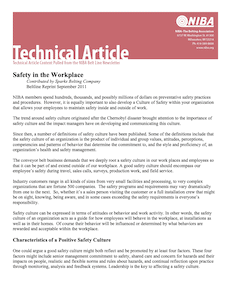
(PDF – 281.01 KB)
PTFE Coated Lightweight Belting
WHAT IS PTFE? Polytetrafluoroethylene (PTFE) coated conveyor belting is a small but important segment of the lightweight belting market. PTFE is sometimes referred to as PTFE, a trademark of DuPont. The generic name is PTFE. For a specific product, check with your supplier before promoting the product as PTFE coated. For this article we will use the generic term PTFE only.
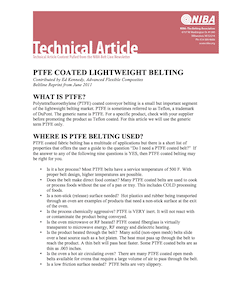
(PDF – 486.03 KB)
Conveyor Transitions
Bulk material conveyors with free flowing products commonly use troughed idlers sets along its length, increasing the belt load carrying capacity. Changing the cross belt profile to a wide “U” shaped high capacity configuration the belt must pass around flat faced terminal pulleys at each end of the system. Within these areas we find the conveyor transition.
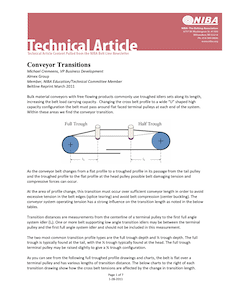
(PDF – 851.59 KB)
Belt Camber: How to Fix Cambered Nylon Core Belting and Prevent Camber in Storage
What is Camber? Camber is the term used to describe an arc or curve that occurs in otherwise straight material. Generally, if camber occurs in belting, it is in a nylon (polyamide) core type material. Nylon core belting is more susceptible to camber than other types of belting because nylon tends to absorb humidity from the surrounding environment more than other materials such as polyester.
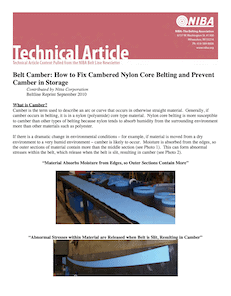
(PDF – 121.58 KB)
Slicers and Belts Prove High Risk for Listeria Contamination
The researchers, in a study published in Food Control said that they investigated the occurrence and genetic diversity of L. monocytogenes in a Swiss sandwich-producing plant over a 12-month period, with the goal of evaluating the potential persistence of L. monocytogenes there in order to identify possible contamination sources. L. monocytogenes as a food-borne pathogen has significant public health and economic impacts with manufacturers of ready-to-eat foods required, under EU regulation, to examine the processing environment for microbe as part of their hazard analysis critical control point (HACCP) approach and sampling schemes.
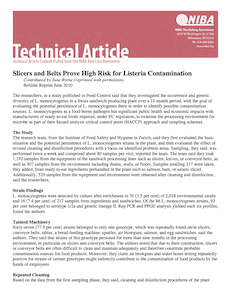
(PDF – 78.10 KB)
How to Design Take-up Travel for a Fabric Conveyor Belt
This article covers the important aspects of fabric conveyor belt elongation and how to design the conveyor system take-up so that adequate take-up travel length is allocated.
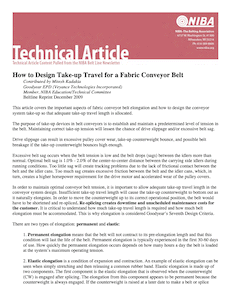
(PDF – 89.34 KB)
Conveyor Belt – New MSHA standard*
On December 31, 2008, the U.S. Department of Labor’s Mine Safety and Heath Administration (MSHA) passed a new regulation for conveyor belts used in a coal mine. The new regulation (30 CFR Parts 14 and 75) requires higher flame resistance than the current regulation (30 CFR Part 18). Per MSHA, the new ruling allows the miners until December 31 2009, to place in service the underground coal mines conveyor parts accepted under existing Part 18.
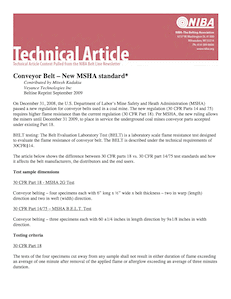
(PDF – 90.27 KB)
MSHA Conveyor Belt “Final Rule”
On December 31, 2008, The U.S. Department of Labor’s Mine Safety and Health Administration (MSHA) published a final rule in the Federal Register that implemented the findings of a Technical Study Panel, pertaining to flame-resistant conveyor belt, fire prevention and detection, and use of air from the belt entry.
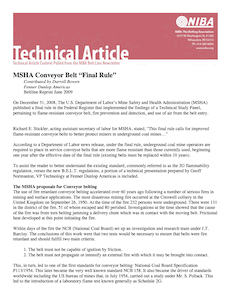
(PDF – 80.23 KB)
Options for an Industrial Slider Bed Application
When considering what type of bottom cover or finish to use in a slider bed application for an industrial conveyor belt, there are a few options to go with. The main factors to think about when making this decision can include anything from the amount of protection needed for the bottom ply to the amount of friction needed or not needed. Hopefully this article will give you a better understanding of these options.
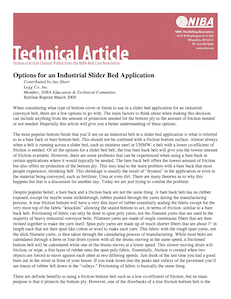
(PDF – 75.22 KB)
Changes in Training: The Coming Exponential Shift to a Knowledge Economy
Today it takes more than a firm handshake and a tool box to be a sales and service conveyor belt distributor. Customers require an ever-higher degree of expertise in the distributor they select to supply, install, splice, and maintain those thousands of miles of conveyor belt in service today.

(PDF – 92.63 KB)
Facility Organization Leads to Profit
When you walked into your warehouse last time, were you happy with what you saw? Did you see this? Materials strewn about; material not in its proper place; people wasting time looking for items to complete a job and having to move items before finding what is needed.
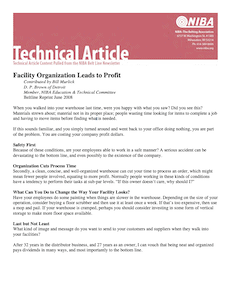
(PDF – 75.42 KB)
The Quicker Splicer Upper
In the world of conveyor belt, there is light duty, medium duty, and heavy duty. The delineation between these is relatively clear, and is generally based upon working tension of the belts. When you talk about light duty belts, the first thing everyone pictures is thin, lightweight, food belts, or black PVC package handling types. There is however, another small group that falls into this category that is mainly overlooked.
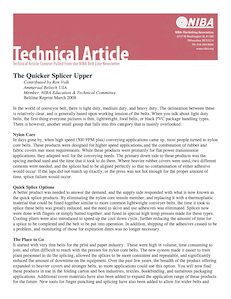
(PDF – 75.93 KB)
Wear Resistance of Rubber Conveyor Belt
One of the most important properties of a conveyor belt is cover wear resistance. As conveyor systems have improved qualitatively in recent years because of improved maintenance and alignment, premature or catastrophic failure has been reduced and gradual wear of the belt covers has become a more common reason for belt change out.
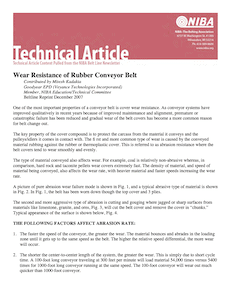
(PDF – 88.34 KB)
Sanitation Aspects of Plastic Modular Belts
Sanitation is a key issue in food processing, but the hygienic design of conveyor belts transporting food products is often overlooked. Staying current with changes in conveyor belts, applications and required design criteria can help to optimize belt selection for performance and sanitation.
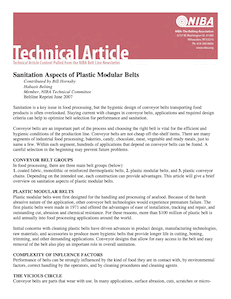
(PDF – 82.16 KB)
Regulatory Oversight of Conveyor Belt for Food Processing
As consumers we share mutual concerns about the suitability of food products produced for public consumption. Likewise, as suppliers to different segments of the food processing industry, we should be aware of the current standards for safe, sanitary food processing and the respective agencies responsible for the maintenance and enforcement of these standards; this is the world in which many of our customers live.
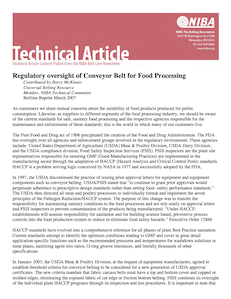
(PDF – 88.19 KB)
Basic Conveyor Safety
The only number of conveyor mishaps acceptable in a plant is zero. Every injury in a plant is costly, affecting worker morale, availability of trained labor, lost production, and increased overhead due to insurance premiums, mountains of paperwork, and possible ?nes from government regulatory agencies. The U.S. Department of Labor, Bureau of Labor Statistics has reported that over 50 workplace fatalities a year are the result of conveyor accidents.
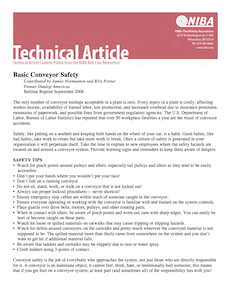
(PDF – 80.85 KB)
Keeping Conveyors Clean—The Why and How
Ant hills, gob, carryback, fugitive material, dirty &-no matter what you call it, it’s that nasty material that has ended up in places other than where it was intended to be conveyed. And it is the stuff that can bring a bulk handling conveyor system to a grinding halt, costing the operation countless dollars in lost material, downtime, clean-up, personnel injuries, and/or damaged conveyor components. There is no doubt that a clean conveyor system makes for a more pro?table operation, but before elaborating on “how” to achieve this lofty goal of a clean conveyor, let’s ?rmly establish “why” it should be viewed as a necessity for any well-managed operation.
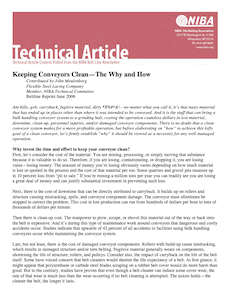
(PDF – 82.16 KB)
Belt Fabrics 101 (Part 2)
Classifying Fabric Yarns and Cord Sizes; Weave Styles There are several methods of classifying fabric yarns or cord sizes. Natural ?bers (cotton) are classi?ed by the English system in which the yarn size number is based on the weight of a hank. Staple ?bers are twisted to form single yarns. These yarns are then measured as a hank, which is 840 yards of material; therefore, a #10 cotton yarn has ten times 840 (8400 yards) of yarn per pound. A #8 cotton yarn would be 6,720 yards per pound. It must be noted that the higher the number, the higher the yield in yards per pound, consequently, the lighter the gauge. A yarn speci?ed as 8/1 means that there is one end of a #8 twisted single and will yield 6,720 yards per pound. A yarn speci?ed as 8/3 means there are three strands of the #8 yarn twisted together. The yield will be approximately 1/3 of resultant yards per pound and about three times the cross sectional area (not gauge). Some yardage and gauge is lost in the twisting. This is referred to as a plied yarn.
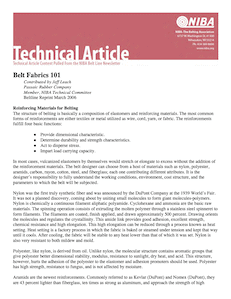
(PDF – 81.58 KB)
Belt Fabrics 101
Reinforcing Materials for Belting The structure of belting is basically a composition of elastomers and reinforcing materials. The most common forms of reinforcements are either textiles or metal utilized as wire, cord, yarn, or fabric. The reinforcements fulfill four basic functions:

(PDF – 97.97 Kb KB)
Non-Metallic Belt Fasteners—The Third Option
Most NIBA members are keenly interested in helping customers keep their conveyors running efficiently and effectively. A major key to achieving this objective is using a belt that is properly specified and properly installed on the conveyor. The two options most frequently pursued to install a belt are vulcanization or some type of metallic mechanical fastener. There are times when a mechanically fastened belt would be prescribed, but is precluded from use because the fastener’s metal construction is inappropriate for the application. It is in applications like these that a third option might be worthy of consideration – non-metallic belt fasteners.
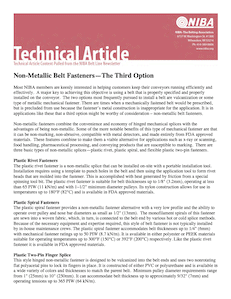
(PDF – 65.44 KB)
Flat Power Transmission Belting
General Uses: To Transmit Power—One of the basic tasks for transmission belting is to transmit power from a source to a driven pulley. This is done through friction between the pulley and the belt, which is transferred through the belt’s core or strength member by way of surface contact and tension.
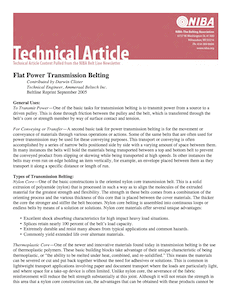
(PDF – 89.10 KB)
Lightweight Belt for Unit Handling Systems
Unit handling systems encompass a broad range of applications and market segments. One could almost say that any conveyor moving an item from Point A to Point B could be considered a unit handling conveyor. Today, conveyors used in warehousing, distribution centers, and baggage handling systems have come to define unit handling applications.
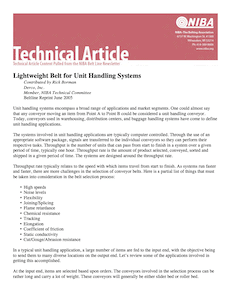
(PDF – 81.36 KB)
Learning the Language of Elevators
This is the second in a series of articles designed to inform readers about the many different types of bucket elevators and their various functions. In the March issue, we’ve already talked about the three types of elevators: centrifugal, continuous, and positive discharge.
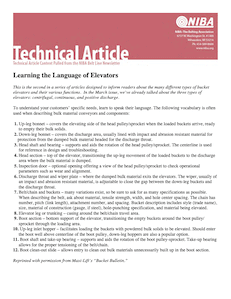
(PDF – 72.15 KB)
Understanding General Bucket Elevator Basics First in a Series
Bucket elevators are designed to move flowing powders or bulk solids vertically. They are attached to an endless spliced loop of belt/chain which travels in a continuous fashion around the tail pulley/sprocket from the boot section of an elevator, where the buckets are loaded.
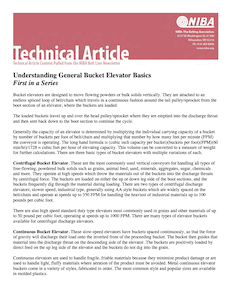
(PDF – 80.78 KB)
The Basics of Lightweight Conveyor Belting
The overall belting market share for lightweight conveyor belting has increased modestly over the past several decades. The primary reasons for the increase are process automation, market globalization, and competition. Process automation has resulted in increased demands on belting that often require the properties of a lightweight belt design. The move toward faster process and transport speeds, combined with compliance to increasingly strict standards in areas such as noise and sanitation, has also favored the growth of lightweight belting.
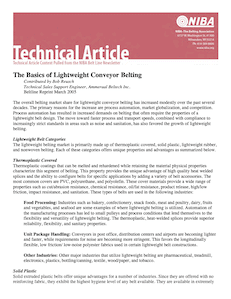
(PDF – 111.05 KB)
Elongation Properties of Heavyweight Conveyor Belting
Conveyor belt elongation properties are critical in determining how heavyweight belts will react when subjected to varying stress levels. These stresses change along the length of the conveyor and across the width of the belt due to system influences such as tension, transitions, vertical and horizontal curves, turnovers, and crowned pulleys.
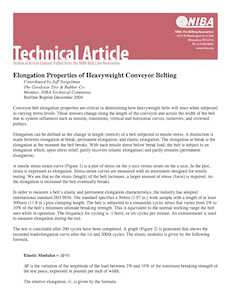
(PDF – 92.34 KB)
Vulcanization (Part 3 of a 3-Part Series)
The vulcanization or curing process occurs in three stages and each stage is of importance and affects the service life of the finished product:
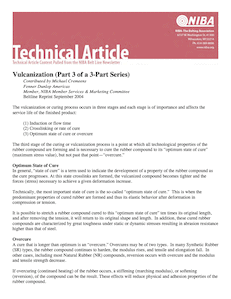
(PDF – 74.08 KB)
Introduction to Plastic Modular Belts
Since their introduction more than 30 years ago, the popularity of plastic modular belts has grown steadily. Constructed of injection-molded modules and hinge rods, plastic modular belts are positively driven and tracked by plastic sprockets. This positive drive and tracking system eliminates slippage, preventing damage to the belt’s edge and the potential for product contamination or premature belt failure.
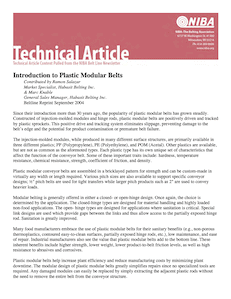
(PDF – 78.37 KB)
Vulcanization (Part 2 of a 3-Part Series)
The vulcanization or curing process occurs in three stages and each stage is of importance and so thus affects the service life of the finished product:
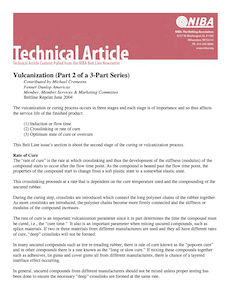
(PDF – 71.58 KB)
Equating Rated Belt Tension to System Requirements
In the conveyor belting industry, it is well known that a thorough understanding of an application’s data is preferable (if not always possible) in order to make a proper belt selection. The reason is clear—we want to know that the selected conveyor belt will operate properly in its environment.
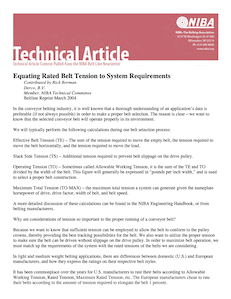
(PDF – 76.09 KB)
Vulcanization (Part 1 of a 3-Part Series)
The vulcanization or curing process occurs in three stages and each stage is of importance and thus affects the service life of the finished product:
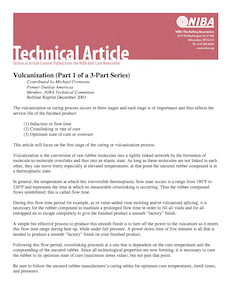
(PDF – 70.47 KB)
Problems Related to Excessive Counterweight on Heavy Duty Belting
It is a common scene, played out in plants throughout North America every day. A plant changes out a high-tension conveyor belt… the one that brings the rock out from the pit to the surge pile.
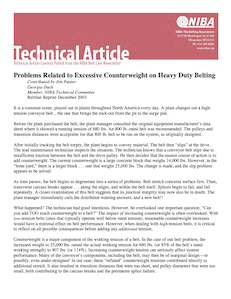
(PDF – 78.11 KB)
Crowned Pulleys
Crowned pulleys are designed to assist in tracking belting in conveyor systems. There are several approaches to the design of crowned pulleys, but they all have the same basic design feature, the center of the pulley has a larger diameter than the outer edges of the pulley, thus the “crown.”
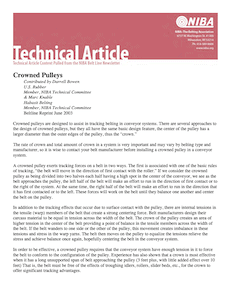
(PDF – 74.94 KB)
Splicing Straight Warp Conveyor Belts
Generally, in the past, finger splices were known and used in lightweight PVC and rubber belts of varying types. The finger splice has also seen limited use in the past on some heavy-duty conveyor straight warp construction belts.
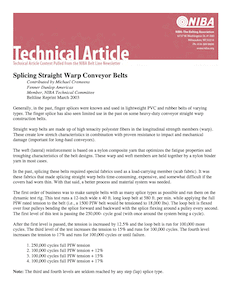
(PDF – 77.28 KB)
NIBA Technical Resources
What type of belt cover will withstand magnesium sulfate? Will rubber work? What type of rubber? How do you explain the term “dynamic fatigue” to a non-belting person? What can you use as a quick introduction to help anyone with belt tracking? Need to know about ISO standards that pertain to conveyor belting?
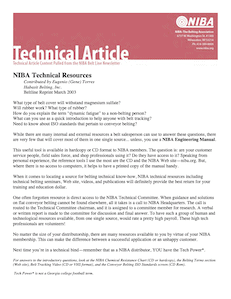
(PDF – 77.53 KB)
Working Strength vs. Breaking Strength
When dealing with conveyor belt tension ratings, it is not uncommon to hear references to working tensions or maximum working tensions and ultimate breaking strength or ultimate tensile strength of a belt. At times there is confusion about the meanings of these ratings. Both of these ratings refer to the capabilities of the carcass of the belt and are interrelated.
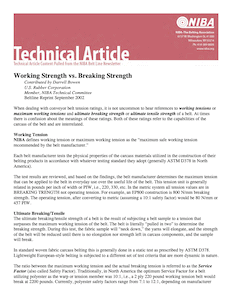
(PDF – 86.59 KB)
Durometer —> Measuring Hardness
For most soft rubber and plastics a Shore A scale is used. The scale covers from 0 to 100 but most instrument makers do not consider it as reliable below 10 or above 90. Softer materials including foams use an OO scale measurement device, while harder materials will be measured using a Shore D scale instrument.
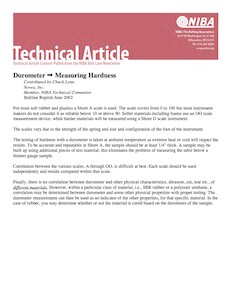
(PDF – 72.20 KB)
Abrasion Resistance of Conveyor Belts
Abrasion resistance of conveyor belt covers is one of the most important properties of a belt. As conveyor systems have improved in quality in recent years because of better maintenance, alignment, and rip detection systems, premature or catastrophic failure has been reduced and gradual wear of the belt covers has become a more common form of belt change out.
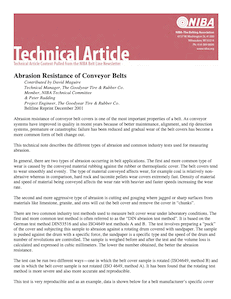
(PDF – 74.53 KB)
Perforated Belting
Sometimes a hole in a belt can help provide a valuable operation in mechanical applications. Perfectly placed holes or slots punched through a belt in a specific pattern typically describes perforated belting. This fabricated belt is utilized in industry to provide a variety of functions. Wood finishing, agricultural, and filtration applications are common.
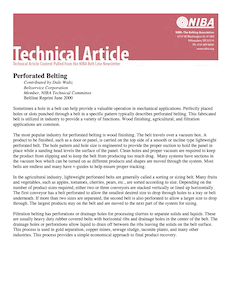
(PDF – 68.85 KB)
